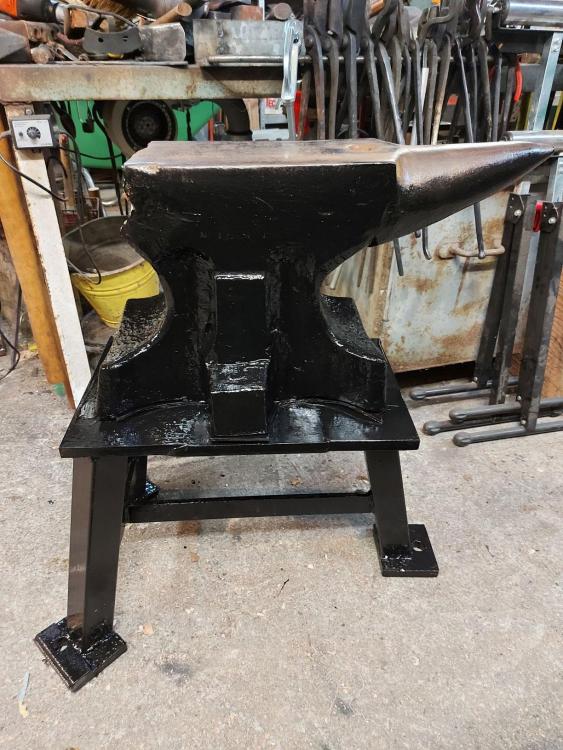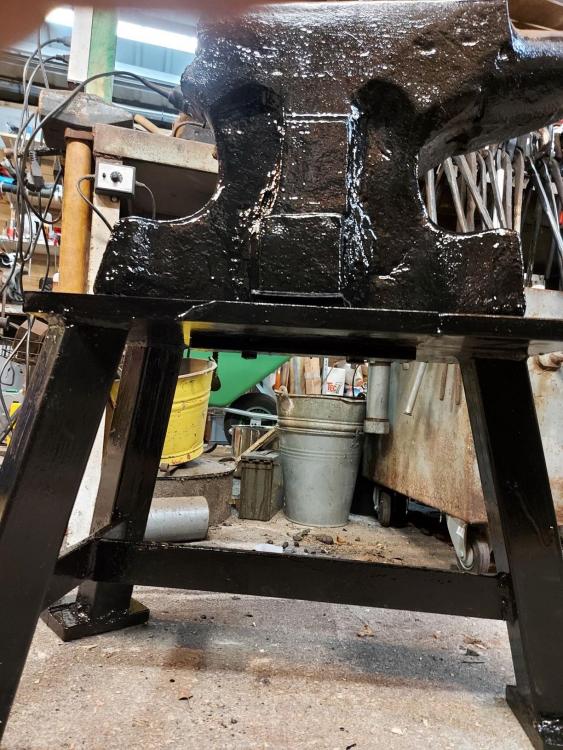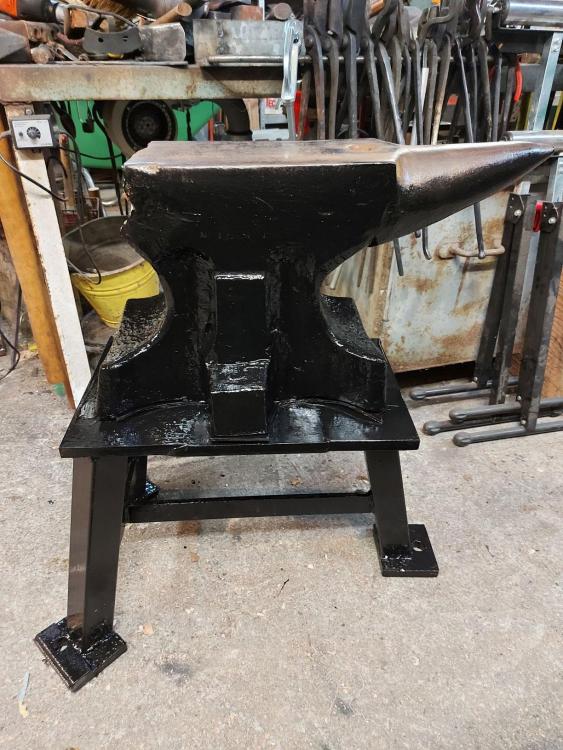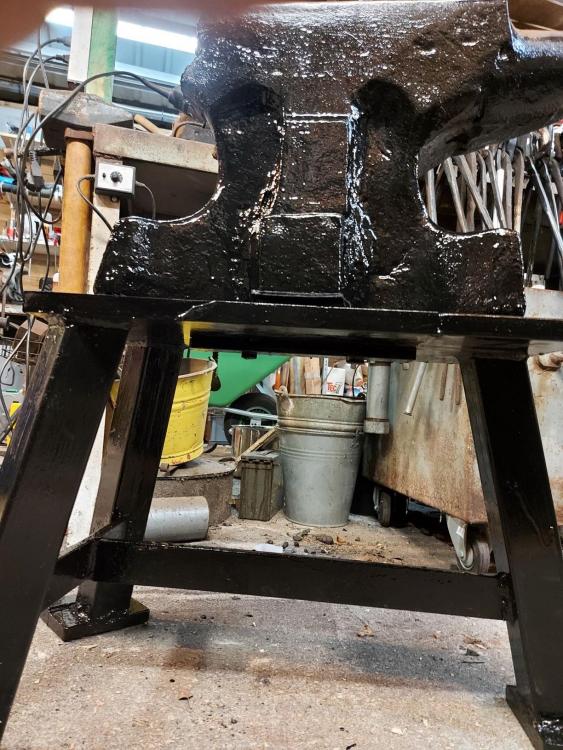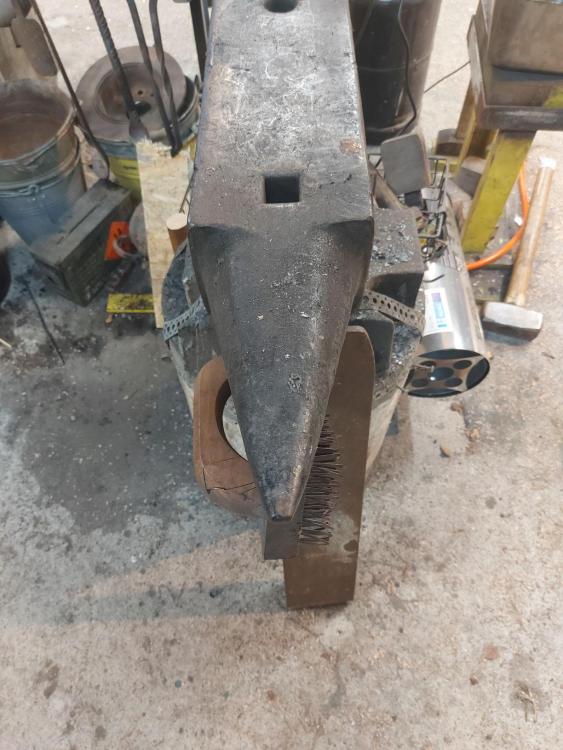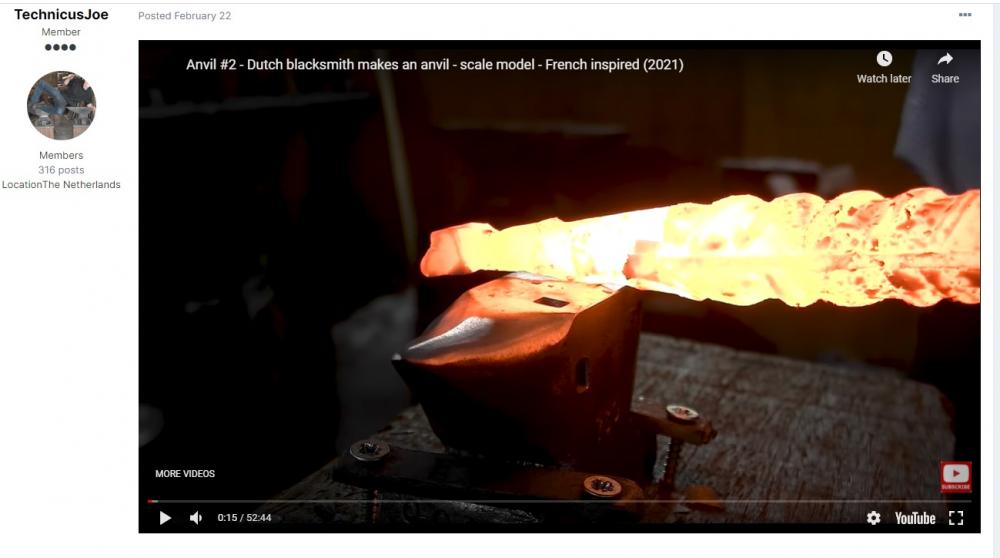
BartW
Members-
Posts
281 -
Joined
-
Last visited
Content Type
Profiles
Forums
Articles
Gallery
Downloads
Events
Everything posted by BartW
-
I'd use a straight grinder with a 1/4' carbide burr. Usually cleans things right up. Sanding drums with ceramics are also goods.
-
How do old anvils stack up against new anvils ?
BartW replied to BartW's topic in Anvils, Swage Blocks, and Mandrels
I think I'll park ... typo. Can't edit for some reason. -
How do old anvils stack up against new anvils ?
BartW replied to BartW's topic in Anvils, Swage Blocks, and Mandrels
If you ever come in this corner of the world (well after this whole situation of lockdowns and virusses is fixed); swing by and try them yourself I'd say I'll provide the beer (for after forging, and we got some good ones here). I didn't snap pictures of the stands; but they are really comparable, as is the mountings method. This is more of a luxury problem than anything else, I'm fully aware of that. I could get by on pretty much any real anvil. Working on the 110 pound vulcan would be "mildly frustrating" for the long haul. It's still amazing how a high-end modern hardened & tempered cast tool steel anvil stacks up against a way older anvil of about double it's weight. I think I'll part the UAT and one skoda in the corner somewhere after painting them; and break them out when doing classes. -
Trying to ID this anvil in France
BartW replied to Wheresmyhammer?'s topic in Anvils, Swage Blocks, and Mandrels
Yup; a UAF anvil. Looks like the 150 kilo model tough. Good steel; one piece cast steel. Very versatile anvils; the round horn gives you pretty much any size of round to hammer on. The hardy hole is something you need to get used to; and make your own tooling for; as stock tooling wont work. You'll also need a soft iron punch to extract the tools. The edges on this one seem very good; almost new. Remember, this is not the anvil to have the apprentice whale on with a 10 pound sledge. -
How do old anvils stack up against new anvils ?
BartW replied to BartW's topic in Anvils, Swage Blocks, and Mandrels
Well; I drew a taper on 3 identical pieces of E-clip (railroad pandrol E-clip fastener). This is 20 mm round 9260 steel; IE; it doesn't move easy under the hammer. I don't really need more punches or chisels, but hey, a couple more never hurts I started with the 1908 wrought Iron + steel face anvil; on a steel tripod foot. I didn't hold back; I used the same 3 pound hammer. What amazed me was the sound. It moved the metal pretty much as I expect it to, I can't really say if it moves more or less compared to the 300-ish pound Skoda. But it sounds better, less high-pitch "ping", more softer, muffled. The anvil face didn't have any issues, not even after I pounded the edges cherry red. The anvil feels more solid; like the center of mass is lower, it doesn't want to move much front-back. So I'd say 95% Next, new piece of steel; skoda anvil. Since I have twins of these; I used both. In this case; I prefer the fixed stump over the steel tripod. Sounds was less fun though. The steel tripod skoda moves more front-to back when drawing on the edges; while the one mounted on the stump (glued to the stump; stump glued to the concrete) didn't. It moves metal about the same tough; and even tough these anvils are literally glass-hard, they don't really chip much after rounding the edges. The sound is more annoying on the steel tripod skoda though. I guess 94 % for the sound, same metal displacement. The steel tripod one get's a 93% for the more annoying sound. Then, off to the UAT. I couldn't use the edges (these are still new - not rounded yet); but it was less effecient. Same annoying sound as the steel tripod skoda. But the metal moved less; if I had to guess; i'd say 90 %. For fun 'n games; I tried a vulcan anvil and a swage block; the vulcan I would range around 75% (sound was much better than on the cast steel ones again); the swage block (mild steel) around 60%. I really like the 1908 anvil; much more than I'd expect to like it. I think the additional mass makes a difference; and the less uniform structure a more pleasant sound. Anyone else some idea's to test these anvils against eachother ? -
Hello; In my little workshop, I have a couple anvils mounted. Mostly for giving classes, I essentially use just one. But when I recently aquired a really old anvil; and found out all others are cast tool steel, I'm kinda curious what I should expect in performance difference. Contenders : This is the one I use all the time (altough I got 2 of 'm): This anvil is on a heavy tripod; and gets used mostly in teaching situations: And this one is recently added : All three are essentially on a heavy steel tripod, and clamped down really hard. The oldest anvil is the most massive & heavy, but you could argue it's also the "weakest" construction, as the actual hard steel is only the top layer. Fun fact; the cart under the skoda above is the excact cart that broke when I put this anvil on it; and the foot of the 1908 anvil is almost as big as the cart, so you have a comparison in size right there. I tested hardness too. The skoda at 300 pounds is face: HRC 62-63 bottom HRC 55. The UAT at 242 pounds is face HRC 60, Feet HRC 50. The 1908 600'ish (used to be 700) pound old anvil's face is around HRC 55, the rest is .. well wrought Iron. Even the HRC 40 file bites it. So I wonder; how would these stack up in use ? Would mass be more important than steel quality ? Or having more mass directly under the hammer ? Would you even notice the difference ? friendly greetings, Bart
-
Creating Rounded Edge on Anvil Face
BartW replied to Kexel Werkstatt's topic in Repairing and Modification to Anvils
You know; I hate grinding and I got a whole LOT to do ... Wanna come over ? -
looks nice ...
-
If the rebound is good, and it sounds good (no sudden differences in tone tapping horn to horn); then it isn't much of a problem. Wrought iron bodied anvils usually have visible weld seams; and it wasn't uncommon to break one and weld it back together ... If you can use; than it's OK.
-
I've seen enough vulcans with issues, and they aren't suitable for working with sledgehammers for example. Well; like Thomas said; it's a second hand ford escort. Will it forge? yes. But don't expect performance and durability like the higher range anvils. The table looks pretty chewed up too. Has there been welding on the edges given that they seem pretty crisp ? I'd bring a really small hammer, and listen to changes in the tone from toe to tip. If it has sudden changes, there's a flaw. These faceplates also break easily; check if you can find halfmoon hairline cracks ( a steel brush helps). If it's all good; then you could buy it. I cannot comment on the price; it's dependant on your location.
-
foot done; and yes, I had to use the crane to get this done ... my back cannot handle an anvil this big.
-
What did you do in the shop today?
BartW replied to Mark Ling's topic in Blacksmithing, General Discussion
-
What did you do in the shop today?
BartW replied to Mark Ling's topic in Blacksmithing, General Discussion
I made a steel tripod for the 1908 anvil I wanted to make it matching ; so I really overbuilt it; and I found this 22mm (almost one inch) plate in the rack; with the excact dimensions I needed. Great. So I start cutting legs to size; mounting them to the plat; filling them with ash and mineral oil; welding on the feet, welding on a T below ... Then I realise I still need two at least 12 mm holes for M12 bolts to hold the anvil down. The drill press destroys 3 or 4 cobalt 6mm drills; and I didn't even got halfway in it. With coolant, slow speed, high speed .. Nope. Looooots of noise; no hole. OK, stubborn as I am; lets break out the carbide tooling. Even that was a no can do; but I did get through with a small diameter. Funny enough, you can file it ... the top layer only as I later found out. So I pick up the fone and call the guy who gave me the plate a couple years back, asking what the hell this thing was. Turns out it's something called Armox; which is an enhanced version of hardox aka military grade armour plate. It's actually layered; the top mm or so doesn't even seem that hard; then it's really hard, the center isn't that hard again, then really hard again before having a softer outer jacket. Sooooo I was stuck. Defeated. I spend half a day trying to make 12mm holes through 22 mm plate and failed. However; since it's under the anvil; and you can't see it anyway; I broke out the plasma cutter. After some cutting from both sides; I now have ugly but functional holes, and all I had to sacrifice is one set of glasses... them sparks always seem to get me. Moral of the story; drill holes in plate before you weld everything to it, or know what kind of plate you're dealing with, and don't go into the shop with your good glasses ... -
Anvil stand mass and stiffness
BartW replied to Dave F's topic in Stands for Anvils, Swage Blocks, etc
Well; if you really wanna overthink this; the power and mass of the magnets also matter; the tiny ones you are using produce the "click", if you would be using really strong heavy magnets, that would even go away :-) I use those on-of welding type square magnets; about 2 pounds each under one horn, and my cleaning brush under the other horn; that usually deafens an anvil completely. -
Anvil stand mass and stiffness
BartW replied to Dave F's topic in Stands for Anvils, Swage Blocks, etc
Now that's a nice carving for your cherry stump. Grab that chisel ! -
Anvil stand mass and stiffness
BartW replied to Dave F's topic in Stands for Anvils, Swage Blocks, etc
What did I say about not overthinking things ? It hurts the noggin' after a while, and you get less work done. Nice cherry stand though; I'd make sure it's as dry as desertsand; remove the bark; and then add some straps around it to prevent it from cracking. And if you keep it dry; you'll have a functional forging setup which your grandchildren can still use. I also like the wedging idea ... It's like how they clamped down sharpening stones; just bigger. -
Glad I don't watch TV anymore. I mean ... there was a time national geografic was nice. But that's long gone it seems.
-
I have really good smell too; I can distiguish between stainless, steel, iron, copper, brass ... the usual metals. But I've also learned that *if* I can smell the metal; that's usually a really BAD sign, as in dust is getting into my lungs.. It also helps detecting propane/butane smell before something blows up. I can swear that people that smell "bad" usually end up incompatible with me. The virus going round, when they said you'd loose your smell, this actually scared me. Your sense of smell is important for some people; and really helpfull too; and I wouldn't want to live without my sense of smell. Now can you use this sense ... well actually yes you can; but not in blacksmithing. Friend of mine works at Nike, and her job is making sure shoeboxes smell nice. She told me there are several "profiles" of olfactory sense; and smelling metal is not really uncommon, but still a usefull profile (which they don't have at nike right now). You'd be amazed how many things really NEED to smell nice to sell
-
Anvil stand mass and stiffness
BartW replied to Dave F's topic in Stands for Anvils, Swage Blocks, etc
Well, actually, yes. The one where I glued the wood stump also to the concrete with the same glue; it feels "heavier" under the hammer. You feel the hit in your feet through the concrete. The other one doesn't vibrate in your shoes I think - and take this with a grain of salt - that the harder you fix your anvil down, in combination with the reduction in resonance-difference between anvil and foot; the more energy will be reflected into the deformation of your work. This is also why a steel tripod with a really strong fixation works so well. I found an article about it once; someone tried to find out how to mathematically find out how heavy an anvil had to be to be "optimal" for a power hammer, in this article they described resonance, vibration; and plastic deformation of the workpiece. They experimentally measured this; and found that from a 1/20 ratio between hammer/anvil; the increases in mass of the anvil didn't really increase deformation proportionally. Below 1/20; it was usefull to get a bigger anvil. They also found that the fixing method of the anvil to the frame mattered in noise, but not in deformation. If I'd find it again, I'd link it. Hence forth power hammer anvils' mass are between 1/5 to 1/20 . Do the experiment of the stump anvil; and you'll be amazed. Take a sledgehammer head; weld a square spike on it; go outside; and beat it in a stump of wood preferably still with roots. You'll be amazed how "heavy" the tiny anvils feels. It's virtually impossible a part of the "experienced mass" doesn't come from the base. But; I have learned to NOT overthink a lot of things, as I tend to do that (a couple good whisky's usually fix that problem ) . Sometimes it's more important to just "do"; and don't worry. A small anvil is no excuses for not delivering good work; and having a massive workshop with all the tools, presses and tons of anvils is no excuse either to not deliver good work. It starts with your mind, you motivation, and flows from there. And once you start working on something, improvise. Half the fun (for me at least) of blacksmithing / bladesmithing is experimenting with stuff. Sometimes it's a bad idea, sometimes it's a good idea. Just like anvils. Try a different foot, try a different fixing method ... in the end you'll find what works best for you; and that's what matters. Yup, I had a bad day, and a good Talisker port rouge in front of me now -
Anvil stand mass and stiffness
BartW replied to Dave F's topic in Stands for Anvils, Swage Blocks, etc
There are solid steel stands for anvils around, and yes, they do add to the overall mass of the anvil. This is why a stump anvil can function at all. This is also why small anvils well fixed to a solid base can work. Joey has a lot of video's on the tube about this ; for example: But other than sheer mass; there's also something like resonance; I don't claim to understand the fysics behind this; but the more rigid your anvil is connected to it's base, the better it will work. I tested this once with industrial glue; and that experiment is still holding up without problems: -
Cool find. But even if it would be "just" mild steel; it's still a whole bunch of Siamese anvils not yet separated from each other And don't bother too much with hardened steel plates; mild steel is just as capabel an anvil as a steel one. I'd argue that a good base is more important than the steel quality, and modern day mild steel is actually fairly good quality.
